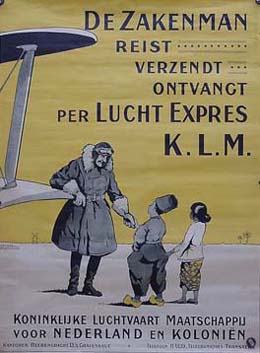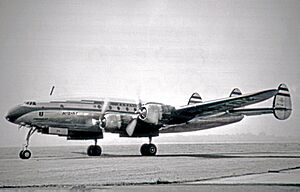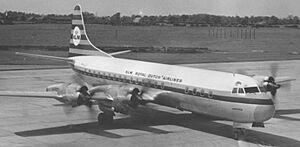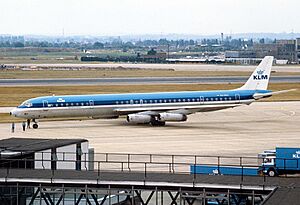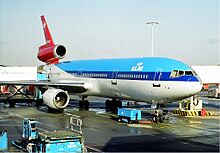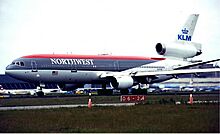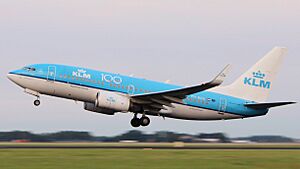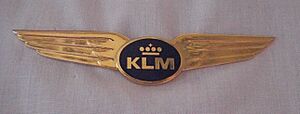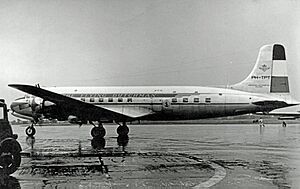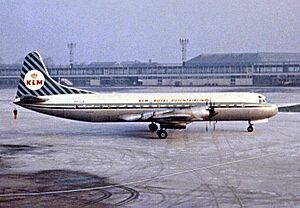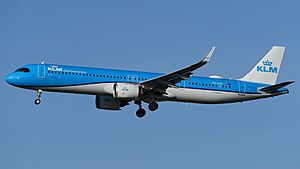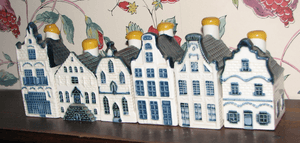KLM facts for kids

A KLM Airbus A321neo
|
|
| Founded | 7 October 1919 |
|---|---|
| Hubs | Amsterdam Airport Schiphol |
| Frequent-flyer program | Flying Blue |
| Alliance | SkyTeam |
| Subsidiaries |
|
| Fleet size | 116 |
| Destinations | 164 |
| Parent company | Air France–KLM |
| Headquarters | Amstelveen, Netherlands |
| Key people | Marjan Rintel (president & CEO) |
| Revenue | €12.6 billion (2024) |
| Net income | €70 million (2024) |
| Employees | 36,071 (2024) |
KLM Royal Dutch Airlines, often called just KLM, is the main airline of the Netherlands. Its full name, Koninklijke Luchtvaart Maatschappij N.V., means "Royal Aviation Company." KLM's main office is in Amstelveen, and its busiest airport hub is Amsterdam Airport Schiphol.
KLM is part of the Air France–KLM group and is a member of the SkyTeam airline alliance. Founded in 1919, KLM is the oldest airline still flying under its original name. The company has a fleet of 110 aircraft and over 35,000 employees. KLM flies to 145 destinations around the world, carrying both passengers and cargo.
History of KLM
How KLM Started
In 1919, a young pilot named Albert Plesman organized a big aviation show in Amsterdam. More than half a million people came to see it! After the show, some Dutch business people decided to create a Dutch airline, and they chose Plesman to lead it.
In September 1919, even before the airline officially started, Queen Wilhelmina gave KLM its "Royal" title. On October 7, 1919, eight Dutch businessmen, including Frits Fentener van Vlissingen, officially founded KLM. This made KLM one of the first commercial airlines ever. Albert Plesman became its first leader.
The very first KLM flight happened on May 17, 1920. KLM's first pilot, Jerry Shaw, flew from Croydon Airport in London to Amsterdam. He used a rented plane, a de Havilland DH-16, carrying two British journalists and some newspapers. In its first year, KLM carried 440 passengers and 22 tons of goods. By April 1921, KLM started regular flights using Fokker F.II and Fokker F.III planes.

KLM's first test flight to another continent took off on October 1, 1924. It flew all the way to Batavia, Dutch East Indies (now Jakarta, Indonesia). This flight used a Fokker F.VII plane and was piloted by Jan Thomassen à Thuessink van der Hoop. In September 1929, KLM began regular flights between Amsterdam and Batavia. This was the world's longest regular airplane route until World War II started in 1939. By 1926, KLM was flying to cities like Amsterdam, Rotterdam, Brussels, Paris, and London.
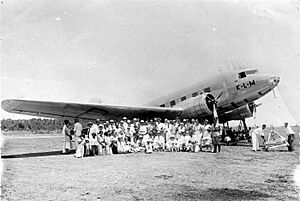
In 1930, KLM carried over 15,000 passengers. The Douglas DC-2 plane was introduced on the Batavia route in 1934. KLM also made its first test flight across the Atlantic Ocean, from Amsterdam to Curaçao, in December 1934.
The first Douglas DC-3 planes arrived in 1936. These planes replaced the DC-2s on the route to Sydney via Batavia. KLM was also the first airline to fly to Manchester's new airport in June 1938.
KLM During World War II
When World War II began in September 1939, KLM's flights were limited. Flights over France and Germany were not allowed. Many of its planes were painted bright orange to avoid being mistaken for military aircraft.
When Germany invaded the Netherlands on May 10, 1940, several KLM planes were flying or were in the Far East. Five DC-3s and one DC-2 were taken to Britain. During the war, these planes and their crews flew passenger flights between Bristol and Lisbon for BOAC.
On March 3, 1942, a KLM Douglas DC-3 plane, named "Pelikaan," was shot down over Western Australia by Japanese planes during an attack. The plane crashed, and three passengers and the flight engineer died.
Even though flights in Europe stopped, KLM continued to fly and grow in the Caribbean region.
After World War II
After World War II ended in August 1945, KLM quickly began to rebuild its flight network. The route to Batavia was restarted by the end of 1945. Flights within Europe and to other countries resumed in September 1945.
On May 21, 1946, KLM became the first European airline to start regular flights across the Atlantic Ocean, between Amsterdam and New York City. By 1948, KLM had rebuilt its network and flights to Africa, North and South America, and the Caribbean were back.
Larger, pressurized planes like the Lockheed Constellation and Douglas DC-6 joined KLM's fleet in the late 1940s. In 1950, KLM carried over 356,000 passengers. The airline continued to add new destinations in the 1950s.
On December 31, 1953, KLM's founder, Albert Plesman, passed away. The airline faced some tough economic times after this. The move to jet aircraft also put a financial strain on KLM. The Dutch government increased its ownership of the company to two-thirds, meaning it partly took over the airline.
On July 25, 1957, KLM started using a flight simulator for its Douglas DC-7C planes. On November 1, 1958, KLM opened a new route from Amsterdam to Tokyo that flew over the North Pole, stopping in Anchorage.
The Jet Age (1960s–1970s)
In March 1960, KLM introduced its first Douglas DC-8 jet plane. In 1961, KLM reported its first year of financial losses. The company went through some leadership changes and reorganizations to help it recover. By 1966, the Dutch government's ownership in KLM was reduced to less than half, making it more of a private company again. In 1966, KLM also introduced the Douglas DC-9 for flights in Europe and the Middle East.
New terminal buildings at Amsterdam Airport Schiphol opened in April 1967. In 1968, the longer Douglas DC-8-63 ("Super DC-8") began service. With 244 seats, it was the largest passenger plane flying at the time. On March 6, 1967, KLM ordered the Boeing 747, which was a very large plane. This marked the start of KLM using wide-body aircraft.
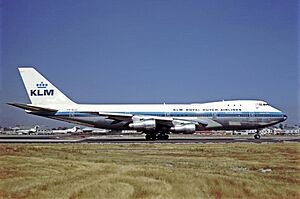
KLM was the first airline to use the 747-200B model, starting on February 14, 1971. In March 1971, KLM opened its current main office in Amstelveen. In 1972, it bought its first McDonnell Douglas DC-10 planes.
In 1973, Sergio Orlandini became KLM's president. He suggested converting some KLM 747s into "combis," which could carry both passengers and cargo on the main deck. In November 1975, the first of these Boeing 747-200BM combi planes were added to KLM's fleet.
The 1973 oil crisis made economic conditions difficult. The Dutch government's ownership in KLM increased again to 78% in the late 1970s. However, the company's management remained under the control of private shareholders.
Growing Globally (1980s–1990s)
In 1980, KLM carried over 9.7 million passengers. In 1983, KLM agreed with Boeing to upgrade ten of its Boeing 747-200 planes. These planes were given a stretched upper deck and were called Boeing 747-200SUD or 747-300. In 1983, KLM also received its first Airbus A310 passenger jets.
In 1986, the Dutch government's share in KLM was reduced to 54.8 percent. The Boeing 747-400 joined KLM's fleet in June 1989.
As air travel became more open in Europe, KLM began to grow its hub at Amsterdam Airport Schiphol. It started working with other airlines to bring more passengers through its hub. To expand its global network, KLM bought a 20% share in Northwest Airlines in July 1989. In 1990, KLM carried 16 million passengers. In December 1991, KLM was the first European airline to start a frequent flyer program, called Flying Dutchman.
Working with Northwest Airlines
In January 1993, the United States government allowed KLM and Northwest Airlines to work together more closely. This meant they could share flights and services. By September 1993, the airlines operated their flights between the United States and Europe as a joint team. In March 1994, KLM and Northwest Airlines introduced "World Business Class" on their international flights. KLM's share in Northwest Airlines increased to 25% in 1994.
KLM introduced the Boeing 767-300ER in July 1995. In January 1996, KLM bought a 26% share in Kenya Airways, the main airline of Kenya. In August 1998, KLM bought back all regular shares from the Dutch government, making KLM a fully private company again.
KLM updated its international fleet by replacing older planes like the Boeing 767s and Boeing 747-300s with newer Boeing 777-200ERs and Airbus A330-200s. The first Boeing 777 arrived on October 25, 2003, and the first Airbus A330-200 was introduced on August 25, 2005.
Joining Air France (2000s)
On September 30, 2003, Air France and KLM agreed to merge. They would become parts of a larger company called Air France-KLM. Both airlines would keep their own names and brands. Charles de Gaulle Airport and Amsterdam Airport Schiphol would become important hubs for the new group.
In February 2004, the merger was approved by authorities. In April 2004, KLM shareholders exchanged their shares for Air France shares. Since May 5, 2004, Air France-KLM has been listed on stock exchanges. The merger was completed in September 2004. This created one of the world's largest airline groups.
KLM and Northwest Airlines joined the SkyTeam alliance in September 2004. In March 2007, KLM started using the Amadeus CRS reservation system. After 10 years, Leo van Wijk stepped down as president and was replaced by Peter Hartman.
KLM in the 2010s
Starting in September 2010, KLM combined the passenger part of Martinair into KLM. By November 2011, Martinair only handled cargo and maintenance. In March 2011, KLM and InselAir agreed to work together, expanding KLM's passenger services.
On February 20, 2013, KLM announced that Peter Hartman would retire as president and CEO on July 1, 2013. He was replaced by Camiel Eurlings. On October 15, 2014, Eurlings resigned, and Pieter Elbers took over as president and CEO.
KLM won the "Best Airline Staff Service" award in Europe at the World Airline Awards in 2013 and 2012. This award recognizes the excellent service from both airport and cabin staff. On June 19, 2012, KLM made the first transatlantic flight partly powered by sustainable biofuels to Rio de Janeiro. This was the longest flight ever on biofuels at that time.
In 2019, KLM celebrated its 100th birthday. Since it is the oldest airline still flying under its original name, it was the first airline to reach this milestone.
KLM in the 2020s
The COVID-19 pandemic greatly affected KLM, leading to job cuts. In December 2021, Air France-KLM ordered 100 Airbus A320neos for KLM and Transavia. In July 2022, KLM had to reduce its summer flight schedule because of problems at airports across Europe.
How KLM Works
Leadership
As of July 2022, KLM's leader is its president and CEO, Marjan Rintel. She took over from Pieter Elbers. The president and CEO is part of a larger Executive Committee that manages KLM. A separate Supervisory Board oversees the company's overall performance.
Main Office
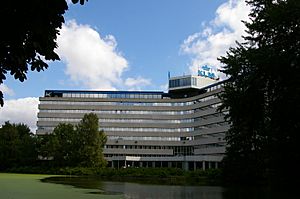
KLM's main office is in Amstelveen, on a 16-acre site near Schiphol Airport. The current headquarters building was built between 1968 and 1970. Before this, the airline's main office was at Schiphol Airport itself.
Other Companies KLM Owns
KLM owns parts of several other companies, including:
- Transavia Airlines CV (100% owned)
- KLM Cityhopper BV (100% owned)
- KLM Cityhopper UK Ltd. (100% owned)
- KLM Asia (100% owned)
- Martinair Holland NV (100% owned)
- EPCOR BV (Maintenance, 100% owned)
- KLM Catering Services Schiphol BV (Catering, 100% owned)
- KLM Flight Academy BV (Flight school, 100% owned)
- Cygnific (Sales and service, 100% owned)
KLM Asia
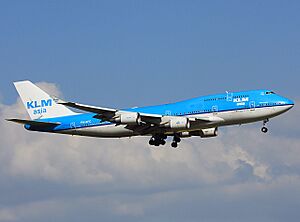
KLM Asia is a company fully owned by KLM, registered in Taiwan. It was created in 1995 so KLM could keep flying to Taipei without affecting its flight rights to mainland China. Planes used by KLM Asia look like regular KLM planes but have some changes: the flags of the Netherlands and European Union are removed, and the Dutch Crown logo is replaced with the "KLM Asia" name.
As of March 2020, KLM Asia uses seven Boeing 777-200ER and two Boeing 777-300ER planes. These planes are also sometimes used for flights to other destinations in the wider KLM network, including China.
KLM's Look and Feel
Dirk Roosenburg designed the first KLM logo in 1919. It showed the letters K, L, and M, with wings and a crown. The crown showed KLM's "Royal" status. The logo was updated in 1961 and again in 1991. KLM also shows its alliance status, like with SkyTeam.
Plane Colors and Uniforms
KLM has used several different paint schemes for its planes over the years. Early planes often had a shiny metal body with a stripe that said "The Flying Dutchman." The tail was painted like the Dutch flag.
Since 1971, KLM planes have mostly been bright blue. Originally, a wide, dark blue stripe covered the windows. In December 2002, KLM updated its look, making the dark blue stripe narrower. The bright blue color still covers most of the plane. In 2014, KLM changed its plane design again, with a swooping blue line that wraps around the front of the plane.
In April 2010, KLM introduced new uniforms for its female flight attendants, ground staff, and pilots. The new uniforms were designed by Dutch designer Mart Visser. They keep the KLM blue color and add a touch of orange, which is the national color of the Netherlands.
In August 2024, KLM introduced a brand new look on its first Airbus A321neo. The blue section now fully covers the nose, and the SkyTeam and Air France-KLM Group logos moved to the tail. The main KLM logo and font were also slightly changed to look more modern.
Marketing Slogans
KLM has used different slogans to advertise over the years:
- "The businessman travels, sends, and receives by KLM" (1920s)
- "The Flying Dutchman"
- "Bridging the World" (1994)
- "The Reliable Airline"
- "Journeys of Inspiration" (2009–present)
Social Media and Games
KLM is very active on social media and has a blog. Customers can ask questions through these channels. The airline also uses social media to share news, marketing campaigns, and special offers.
KLM's use of social media became very important in April 2010 when the Icelandic volcano Eyjafjallajökull erupted. This caused many flight delays. Customers used social media to contact the airline, and KLM used it to give updates. Because of this, KLM created a special social media website called the Social Media Hub in October 2010.
KLM has also created several services using social media:
- Meet & Seat: This service lets passengers find out about other people on their KLM flight by connecting their Facebook or LinkedIn profiles. It helps travelers with similar interests connect.
- Trip Planner: This tool uses Facebook to help organize a trip with friends.
- Twitterbots: KLM has special Twitter accounts that can tell you a flight's status or the lowest fares to a certain place.
In June 2013, KLM launched its own 3D strategy game called "Aviation Empire" for phones and tablets. In the game, players manage KLM from its beginning, investing in planes, building flight networks, and developing airports. The game even lets you unlock airports by checking in with your phone's GPS.
Helping Others
In 1999, KLM started KLM AirCares, a program that helps children in need in developing countries where KLM flies. The airline collects money and frequent flyer miles from passengers for this program.
Where KLM Flies
KLM and its partner airlines fly to 163 destinations in 70 countries across five continents from its main hub at Amsterdam Airport Schiphol. With special agreements called "codeshare agreements," the total number of destinations available through KLM is 826.
In November 2024, KLM announced three new routes from Amsterdam: San Diego, Georgetown, and Hyderabad. These flights started in May, June, and September 2025, respectively. The San Diego and Hyderabad routes are direct, while flights to Georgetown include a short stop in Sint Maarten.
Airlines KLM Works With
KLM has codeshare agreements with many airlines, meaning they share flights. This allows passengers to book a single ticket for a journey that includes flights on different airlines. Some of these airlines include:
- Aerolíneas Argentinas
- Aeroméxico
- Air France
- China Airlines
- Delta Air Lines
- Garuda Indonesia
- Kenya Airways
- Korean Air
- Malaysia Airlines
- Scandinavian Airlines
- Transavia
- Virgin Atlantic
- WestJet
- XiamenAir
KLM's Planes
Plane Strategy
KLM received its first Boeing 787-10 plane on June 28, 2019. This plane had special markings to celebrate KLM's 100th anniversary.
In June 2019, Air France-KLM announced that KLM would not be taking any of the Airbus A350-900 planes that the group had ordered. This was to simplify the types of planes KLM uses.
In December 2021, Air France-KLM ordered 100 Airbus A320neo family planes to replace the Boeing 737 Next Generation planes used by KLM and Transavia.
On September 25, 2023, Air France-KLM announced a new agreement with Airbus for 50 Airbus A350-900 and A350-1000 planes, with an option for 40 more. These planes are expected to be used for international flights starting in 2026.
Special Plane Colors
KLM has several planes with special paint schemes:
- PH-BVA, a Boeing 777-300ER, has an orange front that blends into the standard blue. This celebrates the Netherlands national team's participation in the 2016 Summer Olympics. In November 2023, a new version of this design was launched, replacing the blend with a Dutch flag.
- PH-KZU, a Fokker F70, had a special design featuring Anthony Fokker, the founder of Fokker planes. This celebrated KLM's long history with Fokker aircraft.
- Several planes have the silver SkyTeam alliance colors, including PH-BXO (a 737-900).
- PH-BKA, a Boeing 787-10, has the standard KLM colors but with a "100" wrapped around the lettering. This celebrates KLM's 100th anniversary.
Inside the Plane
KLM has three main seating areas for long international flights: World Business Class, Premium Comfort, and Economy. A part of the Economy cabin has more legroom and is called Economy Comfort. All long-haul planes have personal screens with movies, TV shows, music, games, and options for satellite phone, text, and email. For shorter flights in Europe, there are Economy seats in the back, and Economy Comfort and Europe Business seats in the front.
World Business Class
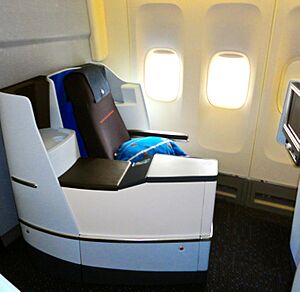
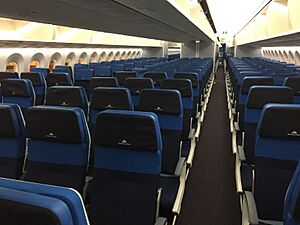
World Business Class is KLM's top seating option for long flights. These seats can recline into a nearly flat bed. They have a personal entertainment system, privacy screens, and power outlets for laptops. On Airbus A330 planes, the seats are arranged with two seats on each side and two in the middle (2–2–2).
In March 2013, KLM introduced a new World Business Class seat. These new seats lie completely flat and have 17-inch high-definition entertainment screens. When flat, the bed is about 2 meters long.
A completely new Business Class seat design was introduced with KLM's Boeing 787 planes. These seats also lie fully flat and are arranged so every passenger has direct access to the aisle (1-2-1 layout). They have a large storage area and a 16-inch HD video screen.
In 2022, KLM announced it would update its Boeing 777 planes with new Business Class seats that have a "door" for extra privacy.
Europe Business Class
Europe Business Class is for shorter flights within Europe. These seats are 17 inches wide. The middle seat in rows of three is kept empty to give passengers more space. Europe Business Class seats have extra legroom and recline more than regular Economy Class seats. Power outlets are available on all Boeing 737 planes.
Premium Economy
In 2022, KLM added a new Premium Comfort section to its long-haul planes. This new cabin is located in front of Economy Comfort and has between 21 and 28 new seats. These seats have a 13-inch touch screen, a movable leg and footrest, and more recline and legroom than Economy seats. Passengers in Premium Comfort also get better food and drinks, and special benefits at the airport.
Economy Comfort
Economy Comfort is a part of the Economy Class cabin on all KLM flights. It gives passengers more legroom and seats that recline further. On long-haul flights, Economy Comfort seats have 4 inches more legroom than regular Economy Class. On short-haul flights, they have 3.5 inches more legroom. Other than the extra space, the service in Economy Comfort is the same as in Economy Class. Economy Comfort is at the front of the Economy cabin, so passengers can leave the plane sooner.
Economy Class
Economy Class seats on long-haul flights have 31 to 32 inches of space between rows and are 17.5 inches wide. All seats have adjustable headrests, a 9-inch screen with movies and TV shows, and a personal satellite phone. Some Airbus A330-300 planes also have power outlets at the seats.
Economy Class seats on short-haul flights have 30 to 31 inches of space between rows and are 17 inches wide. These seats do not have personal entertainment screens.
Services on Board
Entertainment and Wi-Fi
KLM's in-flight entertainment system is available in all classes on its larger planes. It offers movies, TV shows, music, games, and language courses. About 80 movies are available in different languages, and the selection changes every month. You can also send text messages and emails from the entertainment system.
KLM provides international newspapers on long-haul flights and to Europe Business Class passengers on short-haul flights. International magazines are available for World Business Class passengers on long-haul flights. All passengers receive KLM's in-flight magazine, the Holland Herald.
In May 2013, KLM and Air France started testing WiFi internet access on one Boeing 777-300ER plane each. Passengers could use WiFi on their devices once the plane reached 20,000 feet.
Food and Drinks
World Business Class passengers receive a three-course meal. Each year, KLM works with a famous Dutch chef to create the dishes served on board. Europe Business Class passengers get a cold meal, a hot main course, or a three-course meal, depending on how long the flight is.
Economy Class passengers on long-haul flights receive a hot meal and a snack. They also get a second hot meal or breakfast, depending on the flight length. On short-haul flights, passengers get sandwiches or a sweet or savory snack. If the flight is at least two hours long, "stroopwafel" cookies are served before landing. Most alcoholic drinks are free for all passengers.
Special meals, like children's meals, vegetarian meals, or religious meals, can be requested before the flight. On flights to India, China, South Korea, and Japan, KLM offers authentic Asian meals in all classes.
In September 2016, KLM became the first airline to offer draft beer on a flight, in partnership with Heineken. This service started on a flight to Curaçao in World Business Class.
Delft Blue Houses
Since the 1950s, KLM has given its World Business Class passengers a special gift: a Delft blue miniature traditional Dutch house. These small houses are copies of real Dutch houses and are filled with Dutch genever (a type of gin).
KLM started giving these houses to First Class passengers in 1952. When First Class was removed in 1993, the houses were given to all Business Class passengers.
Every year, a new house is introduced on October 7, which is KLM's founding anniversary. The number on the house shows how many years KLM has been flying. Special edition houses, like the Royal Palace of Amsterdam, are given to special guests.
Airport Services
KLM offers different ways for passengers to check in for their flights. You can check in at self-service kiosks at the airport, online, or using a mobile phone or tablet. If these options are not available, you can check in with a KLM employee at the counter. You can get electronic boarding passes on your mobile device or print them at airport kiosks.
Since July 4, 2008, KLM has offered self-service baggage drop-off at Amsterdam Airport Schiphol. Passengers can drop off their bags themselves after a quick check by a KLM employee.
In November 2012, KLM started testing self-service boarding at Amsterdam Airport Schiphol. Passengers could board the plane by scanning their boarding passes, which opened a gate.
KLM was the first airline to offer self-service transfer kiosks for passengers connecting through Amsterdam Airport Schiphol. These kiosks let connecting passengers see flight details, change seats, or upgrade. If a passenger misses a connecting flight, the kiosk can show alternative flights and print a new boarding pass.
Flying Blue Program
Air France-KLM's frequent flyer program is called Flying Blue. It rewards members with miles based on how far they fly, the ticket price, and the class of service. Other airlines like Transavia and TAROM also use the Flying Blue program.
When you fly, you earn Experience Points (XP) and Award Miles. Experience Points determine your membership level (Explorer, Silver, Gold, Platinum). Higher levels come with more benefits. Award Miles can be used for free tickets, upgrades, extra baggage, Wi-Fi, and lounge access. They can also be donated to charities or spent in the Flying Blue Store.
Safety and Incidents
Tenerife Airport Disaster

The Tenerife disaster, which happened on March 27, 1977, was a very serious accident involving a KLM plane. A KLM Boeing 747-200B tried to take off without proper clearance and crashed into a Pan Am Boeing 747-100 that was moving on the runway at Los Rodeos Airport in Tenerife, Spain.
This accident was mainly caused by a misunderstanding in communication between the KLM pilot and air traffic control. Thick fog also played a role, as the KLM crew could not see the Pan Am plane until it was too late. Everyone on the KLM plane died (248 people), and many on the Pan Am plane also died.
This event had a big impact on the airline industry. It led to much stricter rules for communication between pilots and air traffic controllers to prevent such misunderstandings from happening again. For example, the word "takeoff" is now only used by air traffic control when they are giving permission for a plane to take off.
Notable People at KLM
- Jacob Veldhuyzen van Zanten: A pilot known for his role in the Tenerife airport disaster in 1977.
- King Willem-Alexander: The current monarch of the Netherlands, who has worked as a guest pilot for KLM.
See also
 In Spanish: KLM Royal Dutch Airlines para niños
In Spanish: KLM Royal Dutch Airlines para niños
- Air travel in the Netherlands
- List of airports in the Netherlands
- List of companies of the Netherlands


